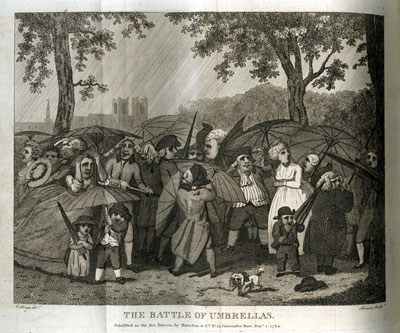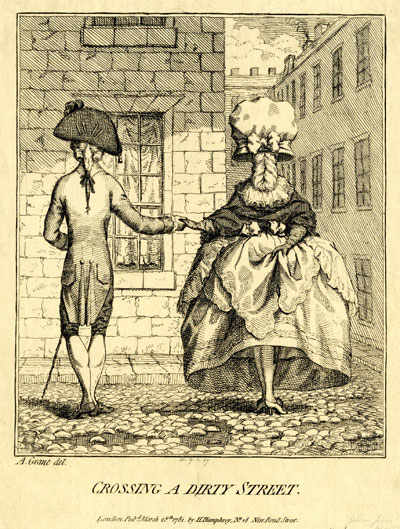A Meeting of Umbrellas
As their open umbrellas jostle for space, three very different men with three very different opinions are so engrossed in a lively discussion that they fail to recognize the simple fact that their umbrellas are no longer necessary: it's not raining.

© Lewis Walpole Library, Yale University
For most of its several thousand-year history, the umbrella was used as what we would now call a parasol–a shield against the sun. It was not until the mid-17th century that the fabrics of umbrellas were successfully treated with wax or oil to make them water-resistant. Given the British climate, however, it was not until the umbrella as parapluie–a shield against the rain–made its appearance that its popularity emigrated from France to England. Initially it was considered a French and feminine accessory. Historical accounts tell us that Jonas Hanway, supposedly the first British man to carry an umbrella in the 1750s, was soundly ridiculed for doing so. But by the 1780s, as Collings' The Battle of Umbrellas (1784) shows, the ubiquity of umbrellas, among women and men (and even children), was now an established fact and a topic for satire.

The Battle of Umbrellas
[September 1, 1784]
© Trustees of the British Museum
But when we compare The Battle of Umbrellas with Gillray's print, I think we also see that Gillray's focus is very different from Collings'. The battle for umbrella space is not primary for Gillray but incidental. The meeting of the still open umbrellas is but the signal of how far their owners have strayed from a potential meeting of the minds.
There was much to discuss and disagree about in January 1782, a lot of it involving the military. News of the calamitous defeat of General Cornwallis and the British army at Yorktown reached London two months earlier on November 25, 1781. When he got word of the terrible results of the battle, the Tory Prime Minister, Lord North, was said to have exclaimed repeatedly, "Oh God! It is all over!" He meant, in effect, both the American war and his own administation. For with the winding down of the American war there was also the complex task of winding down the war with France, America's strongest ally.
But it is surely significant that Gillray provides no details about any of this. We have no idea who these men are, where they are located, or what they are talking about. All we know is what can be inferred from visual clues.
The effete-looking "petite maistre" (as Wright and Grego call him) seems to be the aggressor in this argument. His right hand is raised as if to strike were it not for his umbrella in the way. The sturdy English military man opposite him with a sword holds his own left hand open palm as if defending his position in this argument. The ordinary citizen in the middle puts out his arm between the two opponents as if to say, "Hold on! Calm down." As different as the are in appearance, the men are also different in the attitude in which they are portrayed. The soldier is seen in profile, the citizen face forward, and the fop not quite three quarters.
In its formal simplicity, and understated precision, A Meeting of Umbrellas is perhaps most like Crossing A Dirty Street published a few months later. In both, there is a contast between order and disorder, the order of the print itself which is so simply and carefully etched and the disorder of the situation itself—the colliding umbrellas, an argument that has spun out of control; a dress lifted that exposes an extraordinary amount of leg.

© Trustees of the British Museum
Between 1780 and 1782, Gillray was experimenting with almost every aspect of his career: subject matter, technique, even the publishing process. He was producing beautiful and sophisticated book illustrations, serious portraits of people in the news, sentimental furniture prints, and political and social satire. For his political satires, he was most often using standard national stereotypes or portrait sketches based on existing prints or paintings. But he was beginning to use caricature portraits. He was sometimes publishing on his own and he was certainly freely using aliases. A Meeting of Umbrellas strikes me as another experiment--with finding humor in an everyday event with neither comic exaggeration nor carefully planned background commentary—a kind of minimalist comedy of real life.
Sources and Reading
- Commentary from the British Museum on A Meeting of Umbrellas.
- "Umbrella," Wikipedia
- "18th Century Umbrellas," Jane Austen
- "Umbrella History and Evolution," Fulton Umbrellas
- "Jonas Hanway," Wikipedia
- Thomas Wright and Joseph Grego, The Works of James Gillray, the Caricaturist; With the History of His Life and Times, p. 32
Comments & Corrections
NOTE: Comments and/or corrections are always appreciated. To make that easier, I have included a form below that you can use. I promise never to share any of the info provided without your express permission.